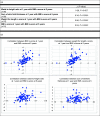Evaluation of anthropometric measures for assessment of cardiometabolic risk in early childhood
- PMID: 32301411
- PMCID: PMC10200522
- DOI: 10.1017/S1368980019004749
Evaluation of anthropometric measures for assessment of cardiometabolic risk in early childhood
Abstract
Objective: Waist-to-height ratio has been shown to be an important indicator of cardiometabolic risk. There are few studies evaluating this measure against existing measures of adiposity and cardiometabolic markers in early childhood. The objectives were: (i) to determine in young children the ability of waist-to-height ratio, BMI z-score, weight for length, and sum of skin fold thickness to predict cardiometabolic risk and (ii) to examine this association at ages 1, 3 and 5 years.
Design: Prospective cohort study.
Setting: A university hospital in Toronto, Ontario.
Participants: Infants at 1 (n 406), 3 (n 112) and 5 years of age (n 94) born to mothers with and without gestational diabetes mellitus.
Results: Weight for length and BMI z-score demonstrated the strongest correlations with biochemical measures compared to waist-to-height ratio, including leptin (at 5 years, weight for length z-score: ρ = 0·65, P < 0·001; BMI z-score: ρ = 0·67, P < 0·001) and measures of insulin resistance (at 3 years, weight for length z-score: ρ = 0·25, P = 0·02; BMI z-score: ρ = 0·24, P = 0·02). The magnitude of associations between anthropometric measures and biochemical measures strengthened over time. Weight for length and BMI z-scores were moderately correlated with overall measures of fat mass as measured by dual-energy X-ray absorptiometry (ρ = 0·65, P = 0·00; ρ = 0·61, P = 0·01).
Conclusions: Waist-to-height ratio was not superior to existing measures in predicting cardiometabolic risk in young children. BMI z-score is a preferred measure of adiposity between birth and 5 years of age.
Keywords: Cardiometabolic risk; Early childhood; Waist-to-height ratio.
Figures
References
-
- De Onis M (2004) The use of anthropometry in the prevention of childhood overweight and obesity. Int J Obes 28, S81–S85. - PubMed
-
- Wells JCK, Chomtho S & Fewtrell MS (2007) Programming of body composition by early growth and nutrition. Proc Nutr Soc 66, 423–434. - PubMed
-
- Geserick M, Vogel M, Gausche R et al. (2018) Acceleration of BMI in early childhood and risk of sustained obesity. N Engl J Med 379, 1303–1312. - PubMed
Publication types
MeSH terms
Substances
LinkOut - more resources
Full Text Sources


